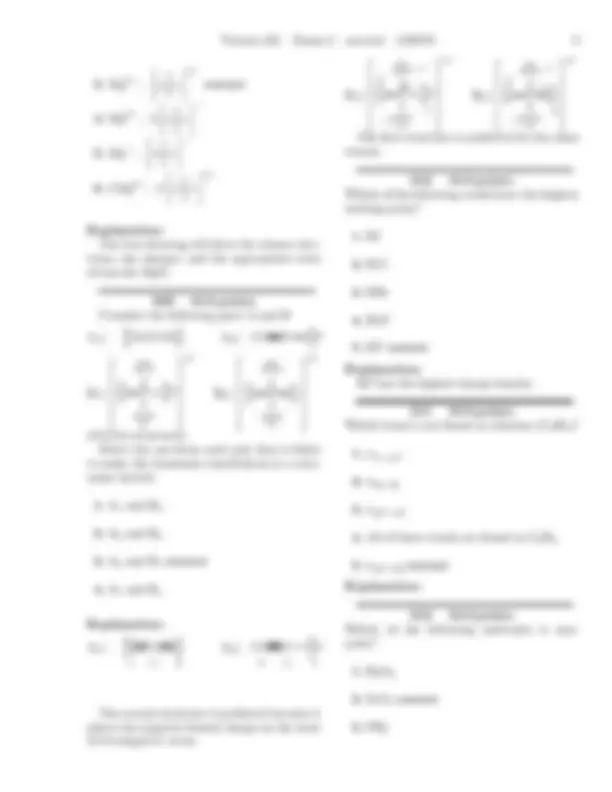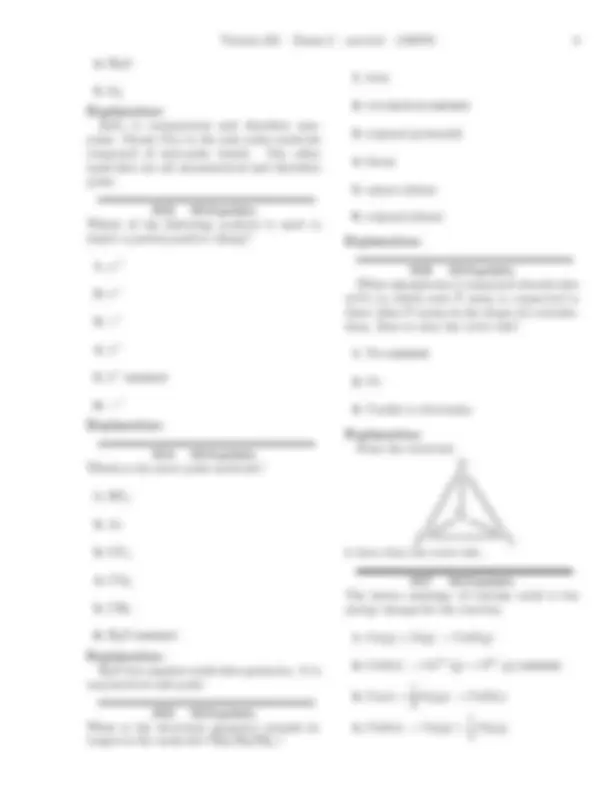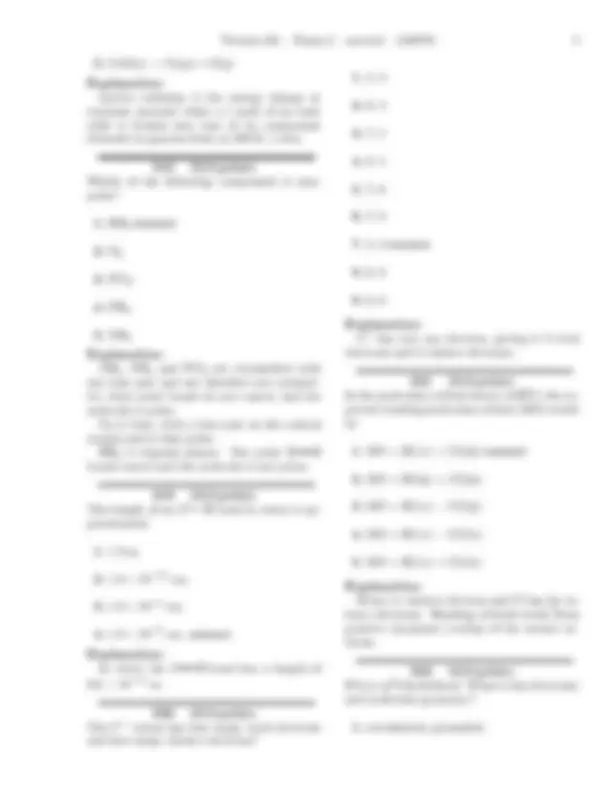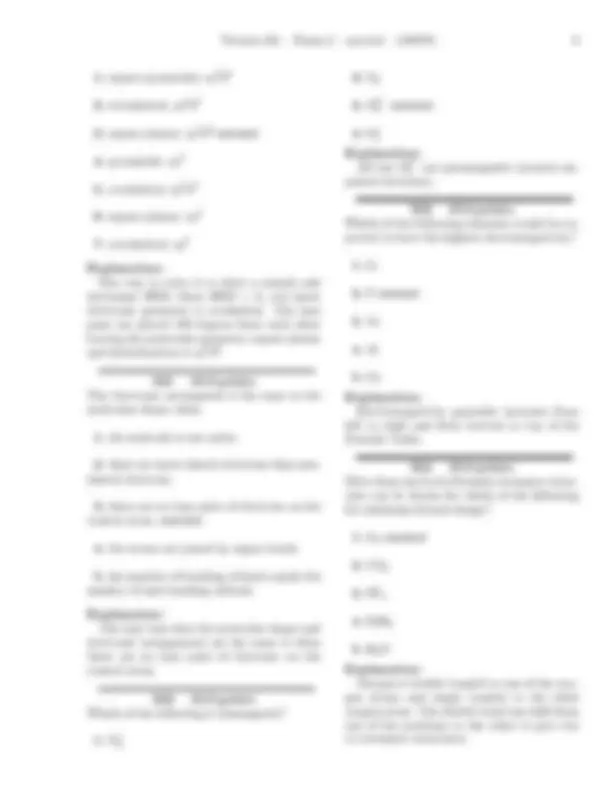






Study with the several resources on Docsity

Earn points by helping other students or get them with a premium plan


Prepare for your exams
Study with the several resources on Docsity

Earn points to download
Earn points by helping other students or get them with a premium plan
Community
Ask the community for help and clear up your study doubts
Discover the best universities in your country according to Docsity users
Free resources
Download our free guides on studying techniques, anxiety management strategies, and thesis advice from Docsity tutors
Material Type: Exam; Professor: McCord; Class: PRINCIPLES OF CHEMISTRY I; Subject: Chemistry; University: University of Texas - Austin; Term: Fall 2010;
Typology: Exams
1 / 8

This page cannot be seen from the preview
Don't miss anything!





This print-out should have 34 questions. Multiple-choice questions may continue on the next column or page – find all choices before answering.
McCord CH
001 10.0 points What is the molecular geometry of SbCl^25 −? Antimony (Sb) can be an exception to the octet rule, accepting up to twelve electrons.
Explanation:
002 10.0 points Which of the following has bond angles of exactly 120◦?
Explanation: While CS^23 − and NO− 2 both have three re- gions of electron density around the central atom, in NO− 2 one of these regions is a lone pair which will repel the other regions more strongly, making the bond angle less than 120 ◦. Only in CS^23 − would the bond angle be exactly 120◦.
003 10.0 points Which of the following has the largest radius?
Explanation: Although size decreases from left to right across the periodic table due to increasing effective nuclear charge, the negative ions will be the largest ions, and the negative ion with the largest charge will have the largest radius since the electrons will repel each other and the effective nuclear charge will be insufficient to overcome this repulsion.
004 10.0 points Consider the following covalent bond radii:
Single Double Triple C 77 pm 67 pm 60 pm N 75 pm 60 pm 55 pm O 74 pm 60 pm - S 102 pm - -
What is the approximate length of the NN bond in nitrogen hydride (HNNH) using the table values?
Explanation: The bond is a double bond so you add 60 pm to 60 pm and get 120 pm.
005 10.0 points In the Lewis dot structure of the molecule ClF 3 , how many unbonded electron pairs are found around the central atom?
Explanation: Draw the Lewis dot structure. ClF 3 has 3 Cl F single bonds and 2 lone pairs on Cl.
006 10.0 points Draw the Lewis structure for CO.
bb b^ Ob^
bb
b (^) b Cb b
bb bb O b b
b b bb bb
b^ b bb b^ Ob
b b bb Cb b
b^ b bb b^ Ob
b (^) b Cbb
bb bb bb Cbb
bb bb bb O bb
b b bb b b
b b bb b b
bb C
b b bb Cb b
Explanation: C has 4 valence electrons; O has 6: b b b C b
b b
bb^ O bb
Total number of valence electrons: C 1 × 4 e−^ = 4 e− O 1 × 6 e−^ = 6 e− 10 e− bb O bb bbbb (^) C bb or bb O Cbb
This configuration gives each atom a com- plete octet.
007 0.0 points EXTRA CREDIT QUESTION: A re- minder here to PLEASE bubble in your name, uteid, and your version number correctly. Do it now - don’t wait till the end of the exam. Also, a reminder that there is NO CLASS tomorrow (Friday, October 8th). That’s right, you get to SKIP chemistry class. I’ll see you on Monday, the 11th, and we’ll start up on Chapter 5. This question starts out at zero points but could very well increase after the grad- ing. Now, if more points are awarded (the curve) on this assignment, would you like them added to your score?
Explanation: This should be a no-brainer. Most students want higher scores. If you picked yes, you got credit for the question and you got the extra points you asked for (if they were granted by your instructor). If you answered NO, you also got what you wanted... no points awarded.
008 10.0 points
Which of the following is the best represen- tation of the compound magnesium oxide?
O bb
bb bb bb
Explanation: XeF 4 is symmetrical and therefore non- polar. Ozone (O 3 ) is the only polar molecule composed of non-polar bonds. The other molecules are all asymmetrical and therefore polar.
013 10.0 points Which of the following symbols is used to depict a partial positive charge?
Explanation:
014 10.0 points Which is the most polar molecule?
Explanation: H 2 O has angular molecular geometry. It is assymetrical and polar.
015 10.0 points What is the electronic geometry around ni- trogen in the molecule CH 3 CH 2 NH 2?
Explanation:
016 10.0 points White phosphorus is composed of molecules of P 4 in which each P atom is connected to three other P atoms in the shape of a tetrahe- dron. Does it obey the octet rule?
Explanation: From the structure
bb
bb
bb bb it does obey the octet rule.
017 10.0 points The lattice enthalpy of calcium oxide is the energy change for the reaction
O 2 (g) → CaO(s)
O 2 (g)
Explanation: Lattice enthalpy is the energy change at constant pressure when a 1 mole of an ionic solid is broken into ions of its component elements in gaseous form at 298 K, 1 atm.
018 10.0 points Which of the following compounds is non- polar?
Explanation: NH 3 , PH 3 and PCl 3 are tetrahedral with one lone pair and are therefore not symmet- ric; their polar bonds do not cancel, and the molecule is polar. O 3 is bent, with a lone pair on the central oxygen and is thus polar. BH 3 is trigonal planar. The polar B H bonds cancel and the molecule is not polar.
019 10.0 points The length of an O H bond in water is ap- proximately
Explanation: In water the O H bond has a length of
9.6 × 10 −^11 m.
020 10.0 points The C+^ cation has how many total electrons and how many valence electrons?
Explanation: C+^ has lost one electron, giving it 5 total electrons and 3 valence electrons.
021 10.0 points In the molecular orbital theory of HCl, the ex- pected bonding molecular orbital (MO) would be
Explanation: H has 1s valence electron and Cl has 3p va- lence electrons. Bonding orbitals result from positive (in-phase) overlap of the atomic or- bitals.
022 10.0 points ICl 3 is sp^3 d hybridized. What is the electronic and molecular geometry?
Explanation: The Lewis structures are N O bbb bb
bb Brbb O bbb bb
bb
bbF bb bb
bb bb
bb
bb
bbbb bb bb
bb
−
Radicals are species with an unpaired elec- tron, so only NO and BrO are radicals.
027 10.0 points Identify the compound with the most polar bond.
Explanation: Calculate the difference in the electronega- tivities (∆EN):
∆EN As H 2. 2 − 2 .2 = 0. 0 N H 3. 0 − 2 .2 = 0. 8 P H 2. 2 − 2 .2 = 0. 0 Sb H 2. 2 − 2 .1 = 0. 1 The N H bond is the most polar of these.
028 10.0 points A molecule has one lone pair of electrons on the central atom and three atoms bonded to the central atom. The central atom follows the octet rule. What is its electronic arrange- ment and its hybridization?
Explanation: One lone pair plus 3 bonded pairs equals 4 electronic regions. This means that the central atom is tetrahedral and hybridization is sp^3.
029 10.0 points What hybridization would you expect for the carbon atoms in the cyclic compound benzene (C 6 H 6 )?
Explanation: In each carbon one s orbital and two p or- bitals hybridize to produce three sp^2 orbitals which form sigma bonds between the carbons and between carbon and hydrogen. The re- maining p orbitals form pi bonds between the carbons.
030 10.0 points A molecule has two lone non-bonded pairs of electrons on the central atom and four atoms bonded to the central atom. What is its molecular shape and its hybridization?
Explanation: One way to solve is to draw a sample and determine HED. Since HED = 6, you know electronic geometry is octahedral. The lone pairs are placed 180 degrees from each other leaving the molecular geometry square planar and hybridization is sp^3 d^2.
031 10.0 points The electronic arrangment is the same as the molecular shape when
Explanation: The only time that the molecular shape and electronic arrangement are the same is when there are no lone pairs of electrons on the central atom.
032 10.0 points Which of the following is diamagnetic?
033 10.0 points Which of the following elements would be ex- pected to have the highest electronegativity?
034 10.0 points More than one Lewis formula resonance struc- ture can be drawn for which of the following for minimum formal charge?